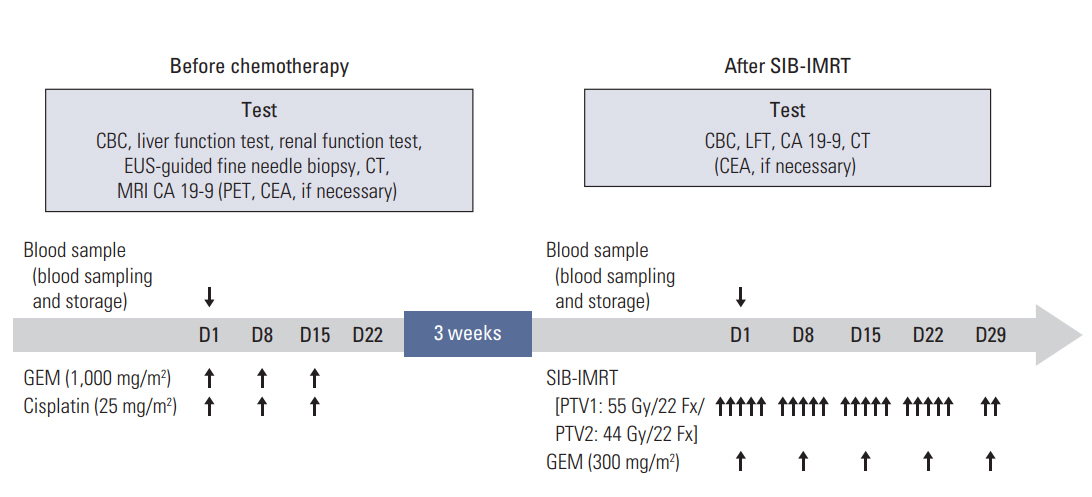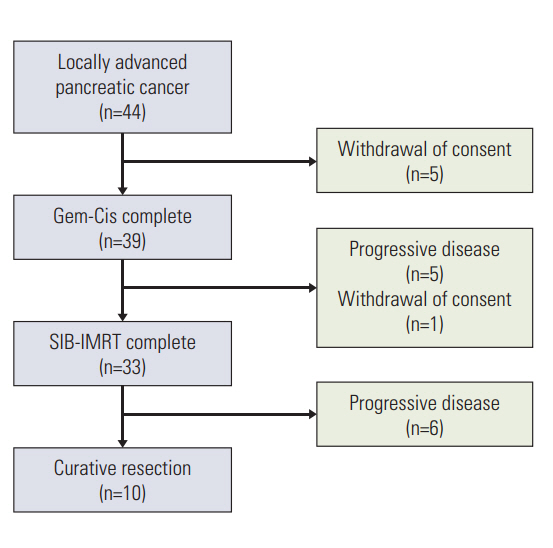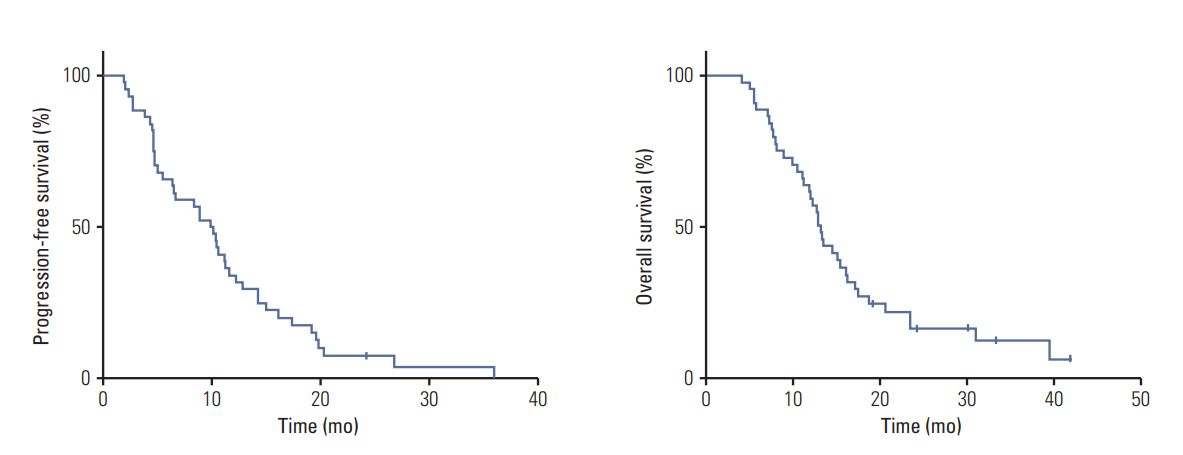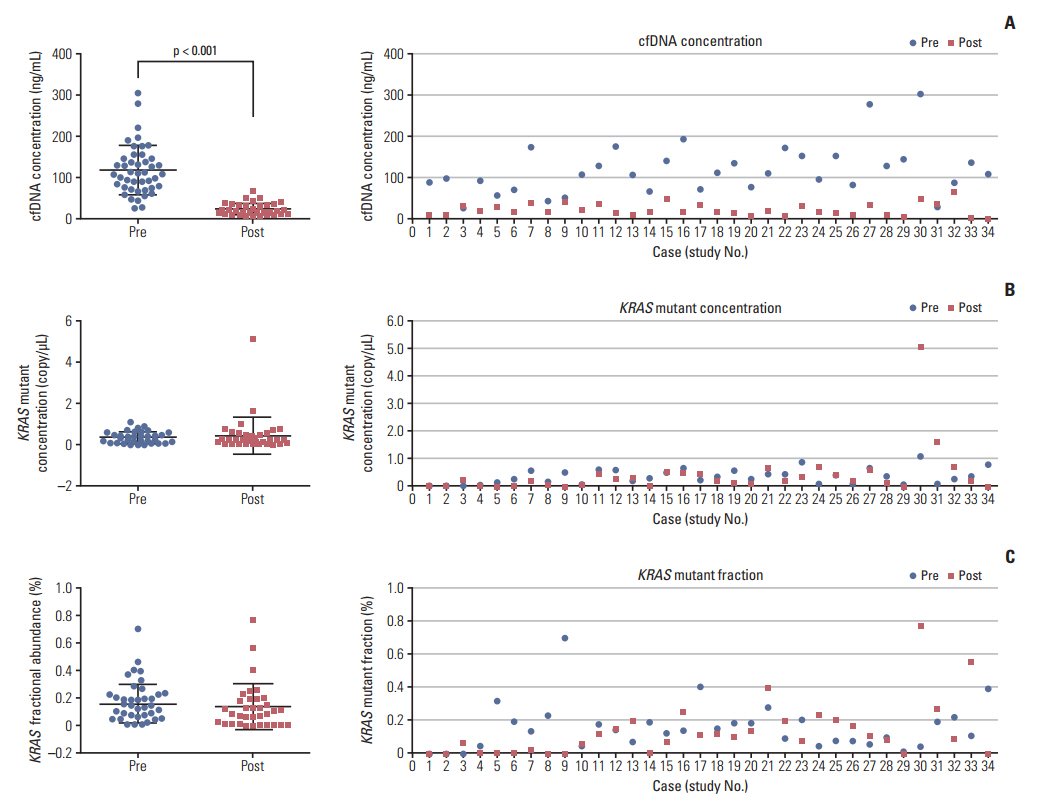Cancer Res Treat.
2017 Oct;49(4):1022-1032. 10.4143/crt.2016.495.
Induction Chemotherapy with Gemcitabine and Cisplatin Followed by Simultaneous Integrated Boost–Intensity Modulated Radiotherapy with Concurrent Gemcitabine for Locally Advanced Unresectable Pancreatic Cancer: Results from a Feasibility Study
- Affiliations
-
- 1Center for Liver Cancer, National Cancer Center, Goyang, Korea. lwj@ncc.re.kr, k2onco@ncc.re.kr
- 2Department of System Cancer Science, Graduate School of Cancer Science and Policy, National Cancer Center, Goyang, Korea. ksy@ncc.re.kr
- 3Biometric Research Branch, Division of Cancer Epidemiology and Prevention, National Cancer Center, Goyang, Korea.
- 4College of Veterinary Medicine, Konkuk University, Seoul, Korea.
- 5Molecular Imaging and Therapy Branch, Research Institute National Cancer Center, Goyang, Korea.
- 6Emergency Department, National Cancer Center, Goyang, Korea.
- 7Department of Laboratory Medicine, Center for Diagnostic Oncology, National Cancer Center, Goyang, Korea.
- KMID: 2394821
- DOI: http://doi.org/10.4143/crt.2016.495
Abstract
- PURPOSE
This study assessed the feasibility and compliance of induction chemotherapy with gemcitabine and cisplatin followed by simultaneous integrated boost-intensity modulated radiotherapy (SIB-IMRT) with concurrent gemcitabine in patients with locally advanced unresectable pancreatic cancer.
MATERIALS AND METHODS
In this trial, patients received induction chemotherapy consisting of gemcitabine (1,000 mg/m²) and cisplatin (25 mg/m²) on days 1, 8, and 15 of each treatment cycle. Patients were subsequently treated with gemcitabine (300 mg/m²/wk) during SIB-IMRT. The patients received total doses of 55 and 44 Gy in 22 fractions to planning target volume 1 and 2, respectively. As an ancillary study, digital polymerase chain reaction was performed to screen for the seven most common mutations in codons 12 and 13 of the KRAS oncogene of circulating cell free DNA (cfDNA).
RESULTS
Forty-four patients were enrolled between 2012 and 2015. Of these, 33 (75%) completed the treatment. The most common toxicities during induction chemotherapy were grades 3 and 4 neutropenia (18.2%), grade 3 nausea (6.8%) and vomiting (6.8%). The most common toxicities during SIB-IMRT were grade 3 neutropenia (24.2%) and grade 3 anemia (12.1%). Ten patients (23%) underwent a curative resection after therapy. Median overall survival was significantly longer in patients who underwent curative resection (16.8 months vs. 11 months, p < 0.01). The median cfDNA concentration was significantly lower after treatment (108.5 ng/mL vs. 18.4 ng/mL, p < 0.001).
CONCLUSION
Induction chemotherapy with gemcitabine and cisplatin followed by concurrent SIB-IMRT was well tolerated and active.
Keyword
MeSH Terms
Figure
Cited by 1 articles
-
Plasma Cell-Free DNA as a Predictive Marker after Radiotherapy for Hepatocellular Carcinoma
Sangjoon Park, Eun Jung Lee, Chai Hong Rim, Jinsil Seong
Yonsei Med J. 2018;59(4):470-479. doi: 10.3349/ymj.2018.59.4.470.
Reference
-
References
1. Ryan DP, Hong TS, Bardeesy N. Pancreatic adenocarcinoma. N Engl J Med. 2014; 371:2140–1.
Article2. Jung KW, Won YJ, Kong HJ, Oh CM, Cho H, Lee DH, et al. Cancer statistics in Korea: incidence, mortality, survival, and prevalence in 2012. Cancer Res Treat. 2015; 47:127–41.
Article3. Chauffert B, Mornex F, Bonnetain F, Rougier P, Mariette C, Bouche O, et al. Phase III trial comparing intensive induction chemoradiotherapy (60 Gy, infusional 5-FU and intermittent cisplatin) followed by maintenance gemcitabine with gemcitabine alone for locally advanced unresectable pancreatic cancer. Definitive results of the 2000-01 FFCD/SFRO study. Ann Oncol. 2008; 19:1592–9.
Article4. Loehrer PJ Sr, Feng Y, Cardenes H, Wagner L, Brell JM, Cella D, et al. Gemcitabine alone versus gemcitabine plus radiotherapy in patients with locally advanced pancreatic cancer: an Eastern Cooperative Oncology Group trial. J Clin Oncol. 2011; 29:4105–12.
Article5. Evans DB, George B, Tsai S. Non-metastatic pancreatic cancer: resectable, borderline resectable, and locally advanced-definitions of increasing importance for the optimal delivery of multimodality therapy. Ann Surg Oncol. 2015; 22:3409–13.
Article6. Ambe C, Fulp W, Springett G, Hoffe S, Mahipal A. A Metaanalysis of randomized clinical trials of chemoradiation therapy in locally advanced pancreatic cancer. J Gastrointest Cancer. 2015; 46:284–90.
Article7. Mukherjee S, Hurt CN, Bridgewater J, Falk S, Cummins S, Wasan H, et al. Gemcitabine-based or capecitabine-based chemoradiotherapy for locally advanced pancreatic cancer (SCALOP): a multicentre, randomised, phase 2 trial. Lancet Oncol. 2013; 14:317–26.
Article8. Colucci G, Giuliani F, Gebbia V, Biglietto M, Rabitti P, Uomo G, et al. Gemcitabine alone or with cisplatin for the treatment of patients with locally advanced and/or metastatic pancreatic carcinoma: a prospective, randomized phase III study of the Gruppo Oncologia dell'Italia Meridionale. Cancer. 2002; 94:902–10.9. Hu J, Zhao G, Wang HX, Tang L, Xu YC, Ma Y, et al. A metaanalysis of gemcitabine containing chemotherapy for locally advanced and metastatic pancreatic adenocarcinoma. J Hematol Oncol. 2011; 4:11.
Article10. Ouyang G, Liu Z, Huang S, Li Q, Xiong L, Miao X, et al. Gemcitabine plus cisplatin versus gemcitabine alone in the treatment of pancreatic cancer: a meta-analysis. World J Surg Oncol. 2016; 14:59.
Article11. Lundberg J, Reardon J, Blazer M, Phillips G, Bekaii-Saab T. Biweekly gemcitabine and low-dose cisplatin in the treatment of locally advanced or metastatic pancreatic cancer patients: a single institute experience. Med Oncol. 2016; 33:4.
Article12. Kim JS, Lim JH, Kim JH, Im SA, Chie EK, Hwang JH, et al. Phase II clinical trial of induction chemotherapy with fixed dose rate gemcitabine and cisplatin followed by concurrent chemoradiotherapy with capecitabine for locally advanced pancreatic cancer. Cancer Chemother Pharmacol. 2012; 70:381–9.
Article13. Hammel P, Huguet F, van Laethem JL, Goldstein D, Glimelius B, Artru P, et al. Effect of chemoradiotherapy vs chemotherapy on survival in patients with locally advanced pancreatic cancer controlled after 4 months of gemcitabine with or without erlotinib: the LAP07 randomized clinical trial. JAMA. 2016; 315:1844–53.14. Peixoto RD, Speers C, McGahan CE, Renouf DJ, Schaeffer DF, Kennecke HF. Prognostic factors and sites of metastasis in unresectable locally advanced pancreatic cancer. Cancer Med. 2015; 4:1171–7.
Article15. Yovino S, Poppe M, Jabbour S, David V, Garofalo M, Pandya N, et al. Intensity-modulated radiation therapy significantly improves acute gastrointestinal toxicity in pancreatic and ampullary cancers. Int J Radiat Oncol Biol Phys. 2011; 79:158–62.
Article16. Bittner MI, Grosu AL, Brunner TB. Comparison of toxicity after IMRT and 3D-conformal radiotherapy for patients with pancreatic cancer: a systematic review. Radiother Oncol. 2015; 114:117–21.17. Youl M, Hashem S, Brade A, Cummings B, Dawson LA, Gallinger S, et al. Induction gemcitabine plus concurrent gemcitabine and radiotherapy for locally advanced unresectable or resected pancreatic cancer. Clin Oncol (R Coll Radiol). 2014; 26:203–9.
Article18. Li D, O'Reilly EM. Adjuvant and neoadjuvant therapy for pancreatic cancer. Surg Oncol Clin N Am. 2016; 25:311–26.
Article19. Nitsche U, Wenzel P, Siveke JT, Braren R, Holzapfel K, Schlitter AM, et al. Resectability after first-line FOLFIRINOX in initially unresectable locally advanced pancreatic cancer: a single-center experience. Ann Surg Oncol. 2015; 22 Suppl 3:S1212–20.
Article20. Nanda RH, El-Rayes B, Maithel SK, Landry J. Neoadjuvant modified FOLFIRINOX and chemoradiation therapy for locally advanced pancreatic cancer improves resectability. J Surg Oncol. 2015; 111:1028–34.
Article21. Ferrone CR, Marchegiani G, Hong TS, Ryan DP, Deshpande V, McDonnell EI, et al. Radiological and surgical implications of neoadjuvant treatment with FOLFIRINOX for locally advanced and borderline resectable pancreatic cancer. Ann Surg. 2015; 261:12–7.
Article22. Suker M, Beumer BR, Sadot E, Marthey L, Faris JE, Mellon EA, et al. FOLFIRINOX for locally advanced pancreatic cancer: a systematic review and patient-level meta-analysis. Lancet Oncol. 2016; 17:801–10.
Article23. Shaib WL, Ip A, Cardona K, Alese OB, Maithel SK, Kooby D, et al. Contemporary management of borderline resectable and locally advanced unresectable pancreatic cancer. Oncologist. 2016; 21:178–87.
Article24. Faisal F, Tsai HL, Blackford A, Olino K, Xia C, De Jesus-Acosta A, et al. Longer course of induction chemotherapy followed by chemoradiation favors better survival outcomes for patients with locally advanced pancreatic cancer. Am J Clin Oncol. 2016; 39:18–26.
Article25. He J, Page AJ, Weiss M, Wolfgang CL, Herman JM, Pawlik TM. Management of borderline and locally advanced pancreatic cancer: where do we stand? World J Gastroenterol. 2014; 20:2255–66.
Article26. Iacobuzio-Donahue CA, Fu B, Yachida S, Luo M, Abe H, Henderson CM, et al. DPC4 gene status of the primary carcinoma correlates with patterns of failure in patients with pancreatic cancer. J Clin Oncol. 2009; 27:1806–13.
Article27. Chambers AF, Groom AC, MacDonald IC. Dissemination and growth of cancer cells in metastatic sites. Nat Rev Cancer. 2002; 2:563–72.
Article28. Koenig A, Mueller C, Hasel C, Adler G, Menke A. Collagen type I induces disruption of E-cadherin-mediated cell-cell contacts and promotes proliferation of pancreatic carcinoma cells. Cancer Res. 2006; 66:4662–71.
Article29. Lennerz JK, Stenzinger A. Allelic ratio of KRAS mutations in pancreatic cancer. Oncologist. 2015; 20:e8–9.
Article30. Kwon MJ, Jeon JY, Park HR, Nam ES, Cho SJ, Shin HS, et al. Low frequency of KRAS mutation in pancreatic ductal adenocarcinomas in Korean patients and its prognostic value. Pancreas. 2015; 44:484–92.
Article
- Full Text Links
- Actions
-
Cited
- CITED
-
- Close
- Share
- Similar articles
-
- Long Term Complete Response of Unresectable Locally Advanced Pancreatic Cancer after CCRT and Gemcitabine Chemotherapy
- Effectiveness and feasibility of concurrent chemoradiotherapy using simultaneous integrated boost-intensity modulated radiotherapy with and without induction chemotherapy for locally advanced pancreatic cancer
- The Results of Radiotherapy in Locally Advanced, Unresectable Pancreatic Cancer
- Chemotherapy for Pancreatic Cancer
- Novel Palliative Chemotherapy for Cholangiocarcinoma





